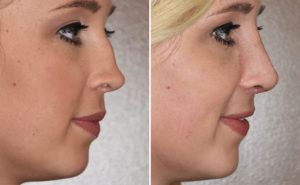Rhinoplasty is the most common facial reshaping procedure with a long and rich surgical history. While techniques for reshaping the nose have changed and evolved over the years, the one issue that has persisted is the need for some form of postoperative compression. It is viewed as an essential element of the surgery and can have a major impact in the final result.
The purpose of postoperative nasal compression is two-fold. The most obvious reason for its use is to keep down the swelling of the nose which will occur. Control of such swelling has great value in an operation that both sits in the middle of your face and is well known to take up to a year to fully go away. Its second purpose, and one of equal value, is to help adapt the skin back down to the reshaped osteocartilaginous nasal framework. If fluid and eventual scar develops underneath the skin, the external appearance of the nose will not show the details of how the new nasal structure actually looks.
The use of tapes and a variety of splints is applied at the end of the operation and usually maintained in placed for a week after surgery. Different types of nasal tapes and splints exist and there are no proven advantages to one method/material over another. What is important is some compression is better than no compression.


Dr. Barry Eppley
Indianapolis, Indiana


